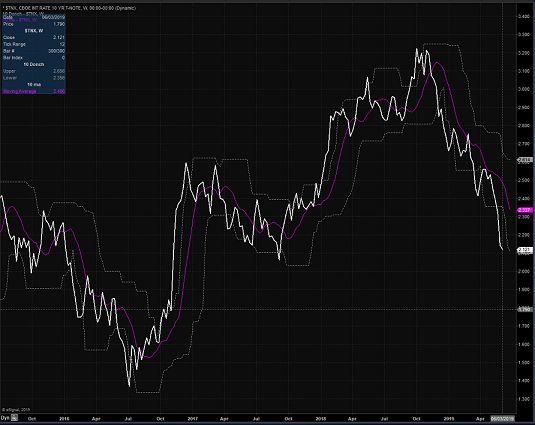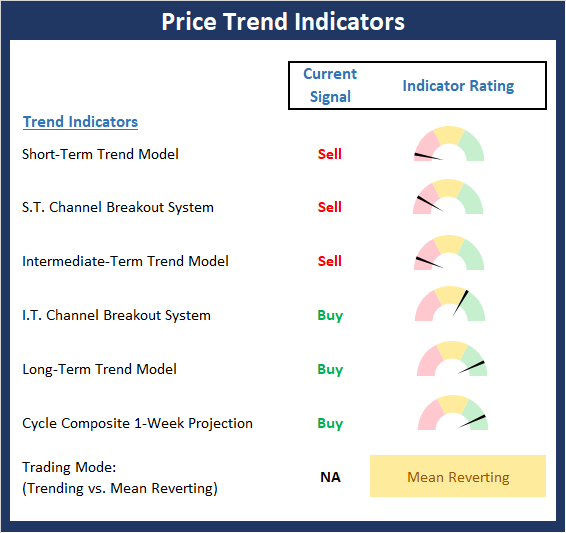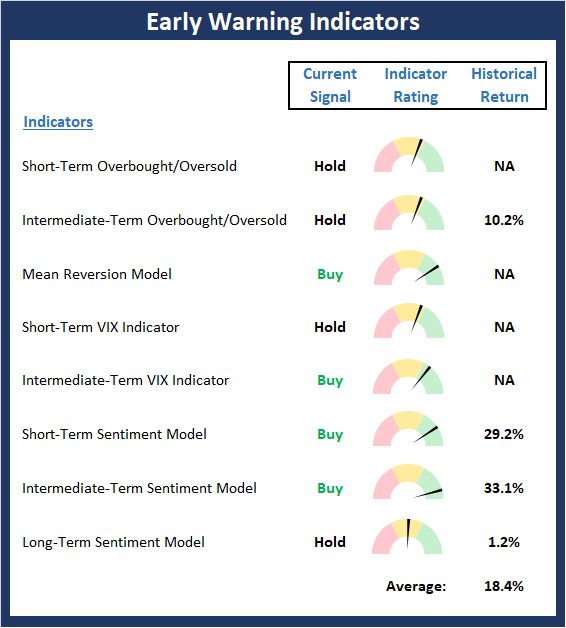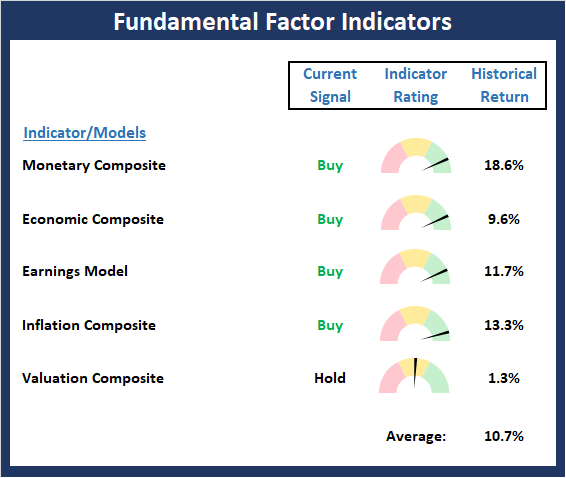There can be little argument that the stock market is a slave to the news at the present time. Friday's surprise pronouncement that the President plans to use tariffs in a new way is exhibit A in this argument. Tweets go out. Threats are made. Uncertainty increases. Stocks are sold. Bonds are bought. Rinse and repeat. Such has been the routine since the beginning of May.
The bears are quick to point out that this is just the beginning. A warm-up act, if you will, for what is sure to come. The glass-is-half-empty gang contends that the "message" from the bond market is a dire one and that stock market investors should (a) pay attention to what the bond market is saying and (b) expect a retest (or worse) of the December debacle.
The Dance To The Downside
In case you missed it, bond yields continued their vigorous dance to the downside last week. The yield on the U.S. 10-Year finished at 2.142%, which was the lowest level since the fall of 2017. And the fact that the yield curve (as defined by the spread between the yields of the 10-year Treasury bond and the 3-month T-bill) has inverted, is also getting a lot of attention. You know, because such an event is generally viewed as a warning of recession.
US 10-Year T-Note Yield - Daily
View Larger Chart
It is also worth noting that the ginormous move in yields isn't limited to our shores. No, European yields are diving as well with a host of benchmarks moving into negative territory again. Heck, even Greek bonds hit their lowest levels in ages last week.
Now toss in the news that the odds (as determined by the futures market) of at least one rate cut this year have spiked and the "message" from the bond market seems to be that the economy is heading in the wrong direction.
There have been numerous reports on the anticipated impact the current trade spat with China will have on the economy. Now analysts are busy calculating the potential damage that could be inflicted from the Mexico thing. The key seems to be that economic uncertainty is on the rise and the risk of recession would appear to be real. Or so the pouting pundits contend.
Mixed Messages
However, I found some interesting research over the weekend from Jim Paulsen, Chief Investment Strategist at the Leuthold Group. As reported in Barron's, Paulsen's work suggests that the "message" from the bond market is at odds from that of the real economy. And based on his historical review, such mixed messages tend to be resolved bullishly in the stock market.
Paulsen went back to 1967 and constructed a model to compare consumer confidence (i.e. the real economy) to the 10-year Treasury yield. He looked for periods when consumer confidence was high, and yields were falling. The thinking is to look at what happens when the real economy is doing well and yet yields were "warning" of problems.
What Paulsen found is that stock market investors should stick with what is actually happening in the economy, as opposed to what bond investors think might happen next.
Specifically, Paulsen found that when his so-called "confidence gap" (the spread between consumer confidence and the 10-year) has been in the highest quartile, the ensuing 6-month return for the S&P 500 averaged 14.3%, which is well above the historical mean - and only 6.7% when the confidence gap was in the lowest quartile.
Paulsen's work also found that the odds of a decline in stocks over the next six months were also much lower when consumer confidence diverged from the "message" of the bond market. When the confidence gap is in the upper quartile, the chances of a loss for the S&P over the next six months was 20.4%. And when the confidence gap is in the lower quartile, the odds of a loss in stocks was almost double at 38%.
Oh, and Paulsen's model is currently in the 93rd percentile of all readings since 1967. So, the odds would seem to suggest that stocks should fare well in the coming six months.
Which Message?
To be sure, there are mixed messages in this market. The bond market message, as told by diving yields and an inverted curve, suggests that the economy is heading for recession. The message from consumer confidence and the labor market would seem to be that everything is just fine, thank you. The message from the stock market is that it's time to worry. The message from the Fed Funds futures suggests that the Fed may have to get even more dovish and take action later this year. And the message from the White House is, well, good luck with that one. Let's just say, it's complicated.
The bottom line is that the mixed messages create, at the very least, uncertainty. And as we all know, the stock market hates uncertainty. So, what do stock traders and their computers do when uncertainty increases? They sell first and as questions later. Of course, this causes millisecond trend-following algos to jump on board the bear train. Which, naturally, leads to a "whoosh" down in the indices and creates additional uncertainty. Again, rinse and repeat.
My Take
For now, at least, my view is that we've got another emotional, news-driven market on our hands. In my experience, this is the type of market where it pays to either "panic early or not at all." As we learned from the December/January-April experience, the news can and often does change quickly. Currently, all the news is bad. Uncertainty reigns supreme. And the expectation is the economy's growth is at risk.
Yet we must keep in mind that we are seeing the sausage being made, so to speak, in terms of ongoing negotiations. And given that it's election season, we can probably expect some good news to occur at some point.
On that note, it would seem to make sense that a trade deal with China might "play" better in the spring of 2020. But then again, the stock market game and to a large degree, the state of the economy, is about confidence. So, something to build a little confidence about the future should probably be expected.
Disclosures
At the time of publication, Mr. Moenning held long positions in the following securities mentioned: None - Note that positions may change at any time.
Weekly Market Model Review
Now let's turn to the weekly review of my favorite indicators and market models...
The State of My Favorite Big-Picture Market Models
There are no changes to the Primary Cycle board this week. While the price action has been weak in response to the trade headlines, the overall "state" of the primary cycle indicators hasn't changed much and the odds continue to favor the bulls from a big-picture standpoint.
This week's mean percentage score of my 6 favorite models was unchanged at 60% (Prior readings: 72.5%, 81.1%, 83.9%, 84.7%, 74.6%, 58.0%) while the median also held steady at 62.5% (Prior readings: 80.0% 82.5%, 86.7%, 86.7%, 81.8%, 65.9%, 50%).

View My Favorite Market Models Online
The State of the Trend
With the President continuing to surprise markets and uncertainty increasing on a daily basis, Captain Obvious tells us that the pullback/corrective phase is likely to continue unabated. As expected, the major indices have all broken below their respective 200-day moving averages, which causes some to change their view of the overall environment. However, with the S&P's 200-day basically flat, such pronouncements should be taken with a fairly large grain of salt.

View Trend Indicator Board Online
The State of Internal Momentum
Not surprisingly, the Momentum Board continues to weaken. And with only one buy signal on the board, an objective analysis suggests that the current decline could become more meaningful in the coming weeks.

View Momentum Indicator Board Online
The State of the "Trade"
The Early Warning board pulled back a bit last week. And while the current setup is not "table pounding" as this time, it is moving in that direction.

View Early Warning Indicator Board Online
The State of the Fundamental Backdrop
There were no changes to the Fundamentals board this week. So the bottom line remains the same: I believe the backdrop continues to support an ongoing bull market once the current corrective phase/news-driven environment plays out. (As long as the trade war doesn't persist and damage the economy, of course.)

View Fundamental Indicator Board Online
Thought For The Day:
The only person you are destined to become is the person you decide to be. – Ralph Waldo Emerson
Wishing you green screens and all the best for a great day,

David D. Moenning
Founder, Chief Investment Officer
Heritage Capital Research
HCR Focuses on a Risk-Managed Approach to Investing
What Risk Management Can and Cannot Do
Leading Indicators Model: A group of indicators that have historically shown tendencies to lead the market at major turning points.
Intermediate-Term Market Model: A composite model (model of models) focused on trend and momentum indicators which has been designed to provide identify intermediate-term trading opportunities.
Risk/Reward Model: A model-of-models intended to provide an overall view of the state of the risk/reward environment. The model includes tape, monetary, and sentiment indicators as well as 7 big-picture market model readings.
Desert Island Model: If I was stranded on a desert island with access to only one market model to manage money with, this would be the model. The model is a comprehensive model-of-models comprised of trend, momentum, mean reversion, economic, monetary, sentiment, and factor-based indicators/models.
External Factors Model: A model-of-models designed to provide a reading on the "macro state" of the market environment. The model is comprised of indicators/models in the areas of various index yields, industrial production, investors sentiment, and historic volatility.
Short-Term Trend-and-Breadth Signal Explained: History shows the most reliable market moves tend to occur when the breadth indices are in gear with the major market averages. When the breadth measures diverge, investors should take note that a trend reversal may be at hand. This indicator incorporates NDR's All-Cap Dollar Weighted Equity Series and A/D Line. From 1998, when the A/D line is above its 5-day smoothing and the All-Cap Equal Weighted Equity Series is above its 25-day smoothing, the equity index has gained at a rate of +32.5% per year. When one of the indicators is above its smoothing, the equity index has gained at a rate of +13.3% per year. And when both are below, the equity index has lost +23.6% per year.
Channel Breakout System Explained: The short-term and intermediate-term Channel Breakout Systems are modified versions of the Donchian Channel indicator. According to Wikipedia, "The Donchian channel is an indicator used in market trading developed by Richard Donchian. It is formed by taking the highest high and the lowest low of the last n periods. The area between the high and the low is the channel for the period chosen."
Intermediate-Term Trend-and-Breadth Signal Explained: This indicator incorporates NDR's All-Cap Dollar Weighted Equity Series and A/D Line. From 1998, when the A/D line is above its 45-day smoothing and the All-Cap Equal Weighted Equity Series is above its 45-day smoothing, the equity index has gained at a rate of +17.6% per year. When one of the indicators is above its smoothing, the equity index has gained at a rate of +6.5% per year. And when both are below, the equity index has lost -1.3% per year.
Cycle Composite Projections: The cycle composite combines the 1-year Seasonal, 4-year Presidential, and 10-year Decennial cycles. The indicator reading shown uses the cycle projection for the upcoming week.
Trading Mode Indicator: This indicator attempts to identify whether the current trading environment is "trending" or "mean reverting." The indicator takes the composite reading of the Efficiency Ratio, the Average Correlation Coefficient, and Trend Strength models.
Volume Relationship Models: These models review the relationship between "supply" and "demand" volume over the short- and intermediate-term time frames.
Price Thrust Model Explained: This indicator measures the 3-day rate of change of the Value Line Composite relative to the standard deviation of the 30-day average. When the Value Line's 3-day rate of change have moved above 0.5 standard deviation of the 30-day average ROC, a "thrust" occurs and since 2000, the Value Line Composite has gained ground at a rate of +20.6% per year. When the indicator is below 0.5 standard deviation of the 30-day, the Value Line has lost ground at a rate of -10.0% per year. And when neutral, the Value Line has gained at a rate of +5.9% per year.
Volume Thrust Model Explained: This indicator uses NASDAQ volume data to indicate bullish and bearish conditions for the NASDAQ Composite Index. The indicator plots the ratio of the 10-day total of NASDAQ daily advancing volume (i.e., the total volume traded in stocks which rose in price each day) to the 10-day total of daily declining volume (volume traded in stocks which fell each day). This ratio indicates when advancing stocks are attracting the majority of the volume (readings above 1.0) and when declining stocks are seeing the heaviest trading (readings below 1.0). This indicator thus supports the case that a rising market supported by heavier volume in the advancing issues tends to be the most bullish condition, while a declining market with downside volume dominating confirms bearish conditions. When in a positive mode, the NASDAQ Composite has gained at a rate of +38.3% per year, When neutral, the NASDAQ has gained at a rate of +13.3% per year. And when negative, the NASDAQ has lost at a rate of -14.279% per year.
Breadth Thrust Model Explained: This indicator uses the number of NASDAQ-listed stocks advancing and declining to indicate bullish or bearish breadth conditions for the NASDAQ Composite. The indicator plots the ratio of the 10-day total of the number of stocks rising on the NASDAQ each day to the 10-day total of the number of stocks declining each day. Using 10-day totals smooths the random daily fluctuations and gives indications on an intermediate-term basis. As expected, the NASDAQ Composite performs much better when the 10-day A/D ratio is high (strong breadth) and worse when the indicator is in its lower mode (weak breadth). The most bullish conditions for the NASDAQ when the 10-day A/D indicator is not only high, but has recently posted an extreme high reading and thus indicated a thrust of upside momentum. Bearish conditions are confirmed when the indicator is low and has recently signaled a downside breadth thrust. In positive mode, the NASDAQ has gained at a rate of +22.1% per year since 1981. In a neutral mode, the NASDAQ has gained at a rate of +14.5% per year. And when in a negative mode, the NASDAQ has lost at a rate of -6.4% per year.
Short-Term Overbought/sold Indicator: This indicator is the current reading of the 14,1,3 stochastic oscillator. When the oscillator is above 80 and the %K is above the %D, the indicator gives an overbought reading. Conversely, when the oscillator is below 20 and %K is below its %D, the indicator is oversold.
Intermediate-Term Overbought/sold Indicator: This indicator is a 40-day RSI reading. When above 57.5, the indicator is considered overbought and wnen below 45 it is oversold.
Mean Reversion Model: This is a diffusion model consisting of five indicators that can produce buy and sell signals based on overbought/sold conditions.
VIX Indicator: This indicators looks at the current reading of the VIX relative to standard deviation bands. When the indicator reaches an extreme reading in either direction, it is an indication that a market trend could reverse in the near-term.
Short-Term Sentiment Indicator: This is a model-of-models composed of 18 independent sentiment indicators designed to indicate when market sentiment has reached an extreme from a short-term perspective. Historical analysis indicates that the stock market's best gains come after an environment has become extremely negative from a sentiment standpoint. Conversely, when sentiment becomes extremely positive, market returns have been subpar.
Intermediate-Term Sentiment Indicator: This is a model-of-models composed of 7 independent sentiment indicators designed to indicate when market sentiment has reached an extreme from a intrmediate-term perspective. Historical analysis indicates that the stock market's best gains come after an environment has become extremely negative from a sentiment standpoint. Conversely, when sentiment becomes extremely positive, market returns have been subpar.
Long-Term Sentiment Indicator: This is a model-of-models composed of 6 independent sentiment indicators designed to indicate when market sentiment has reached an extreme from a long-term perspective. Historical analysis indicates that the stock market's best gains come after an environment has become extremely negative from a sentiment standpoint. Conversely, when sentiment becomes extremely positive, market returns have been subpar.
Absolute Monetary Model Explained: The popular cliche, "Don't fight the Fed" is really a testament to the profound impact that interest rates and Fed policy have on the market. It is a proven fact that monetary conditions are one of the most powerful influences on the direction of stock prices. The Absolute Monetary Model looks at the current level of interest rates relative to historical levels and Fed policy.
Relative Monetary Model Explained: The "relative" monetary model looks at monetary indicators relative to recent levels as well as rates of change and Fed Policy.
Economic Model Explained: During the middle of bull and bear markets, understanding the overall health of the economy and how it impacts the stock market is one of the few truly logical aspects of the stock market. When our Economic model sports a "positive" reading, history (beginning in 1965) shows that stocks enjoy returns in excess of 21% per year. Yet, when the model's reading falls into the "negative" zone, the S&P has lost nearly -25% per year. However, it is vital to understand that there are times when good economic news is actually bad for stocks and vice versa. Thus, the Economic model can help investors stay in tune with where we are in the overall economic cycle.
Inflation Model Explained: They say that "the tape tells all." However, one of the best "big picture" indicators of what the market is expected to do next is inflation. Simply put, since 1962, when the model indicates that inflationary pressures are strong, stocks have lost ground. Yet, when inflationary pressures are low, the S&P 500 has gained ground at a rate in excess of 13%. The bottom line is inflation is one of the primary drivers of stock market returns.
Valuation Model Explained: If you want to get analysts really riled up, you need only to begin a discussion of market valuation. While the question of whether stocks are overvalued or undervalued appears to be a simple one, the subject is actually extremely complex. To simplify the subject dramatically, investors must first determine if they should focus on relative valuation (which include the current level of interest rates) or absolute valuation measures (the more traditional readings of Price/Earnings, Price/Dividend, and Price/Book Value). We believe that it is important to recognize that environments change. And as such, the market's focus and corresponding view of valuations are likely to change as well. Thus, we depend on our Valuation Models to help us keep our eye on the ball.
Disclosures
NOT INVESTMENT ADVICE. The opinions and forecasts expressed herein are those of Mr. David Moenning and may not actually come to pass. Mr. Moenning's opinions and viewpoints regarding the future of the markets should not be construed as recommendations. The analysis and information in this report is for informational purposes only. No part of the material presented in this report is intended as an investment recommendation or investment advice. Neither the information nor any opinion expressed constitutes a solicitation to purchase or sell securities or any investment program.
Any investment decisions must in all cases be made by the reader or by his or her investment adviser. Do NOT ever purchase any security without doing sufficient research. There is no guarantee that the investment objectives outlined will actually come to pass. All opinions expressed herein are subject to change without notice. Neither the editor, employees, nor any of their affiliates shall have any liability for any loss sustained by anyone who has relied on the information provided.
Mr. Moenning is an investment adviser representative of Eastsound Capital Advisors, a registered investment advisor. Neither Mr. Moenning nor Eastsound is registered as a broker-dealer.
Mr. Moenning may at times have positions in the securities referred to and may make purchases or sales of these securities while publications are in circulation. Positions may change at any time.
The analysis provided is based on both technical and fundamental research and is provided "as is" without warranty of any kind, either expressed or implied. Although the information contained is derived from sources which are believed to be reliable, they cannot be guaranteed.
Investments in equities carry an inherent element of risk including the potential for significant loss of principal. Past performance is not an indication of future results.

